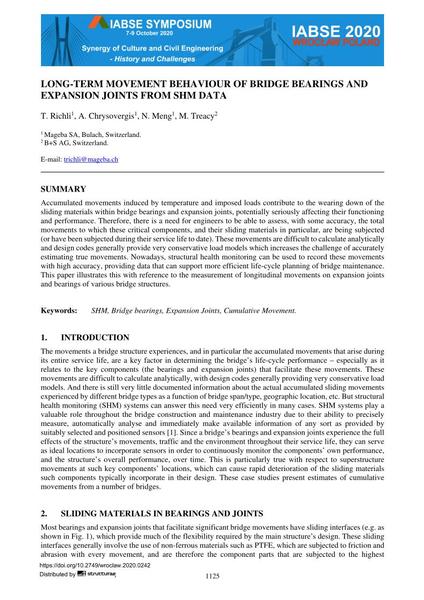Long-Term Movement Behaviour of Bridge Bearings and Expansion Joints from SHM Data

|
|
|||||||||||
Bibliografische Angaben
| Autor(en): |
T. Richli
(Mageba SA, Bulach, Switzerland)
A. Chrysovergis (Mageba SA, Bulach, Switzerland) N. Meng (Mageba SA, Bulach, Switzerland) M. Treacy (B+S AG, Switzerland) |
||||
|---|---|---|---|---|---|
| Medium: | Tagungsbeitrag | ||||
| Sprache(n): | Englisch | ||||
| Tagung: | IABSE Symposium: Synergy of Culture and Civil Engineering – History and Challenges, Wrocław, Poland, 7-9 October 2020 | ||||
| Veröffentlicht in: | IABSE Symposium Wroclaw 2020 | ||||
|
|||||
| Seite(n): | 1125-1132 | ||||
| Anzahl der Seiten (im PDF): | 8 | ||||
| Jahr: | 2020 | ||||
| DOI: | 10.2749/wroclaw.2020.0242 | ||||
| Abstrakt: |
Accumulated movements induced by temperature and imposed loads contribute to the wearing down of the sliding materials within bridge bearings and expansion joints, potentially seriously affecting their functioning and performance. Therefore, there is a need for engineers to be able to assess, with some accuracy, the total movements to which these critical components, and their sliding materials in particular, are being subjected (or have been subjected during their service life to date). These movements are difficult to calculate analytically and design codes generally provide very conservative load models which increases the challenge of accurately estimating true movements. Nowadays, structural health monitoring can be used to record these movements with high accuracy, providing data that can support more efficient life-cycle planning of bridge maintenance. This paper illustrates this with reference to the measurement of longitudinal movements on expansion joints and bearings of various bridge structures. |
||||
| Stichwörter: |
Brückenlager Fahrbahnübergänge
|
||||
